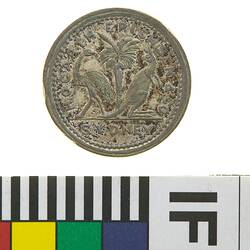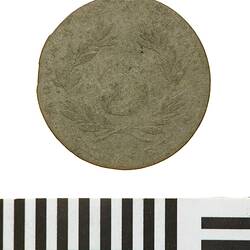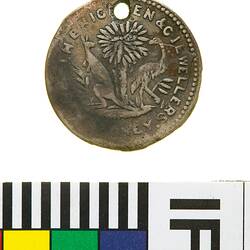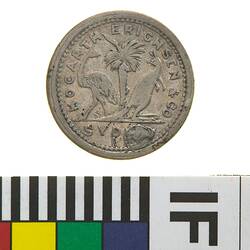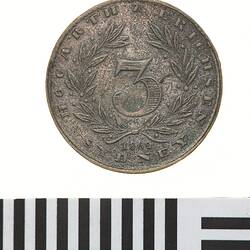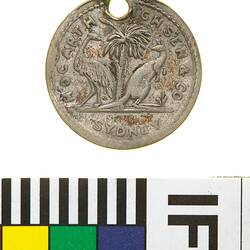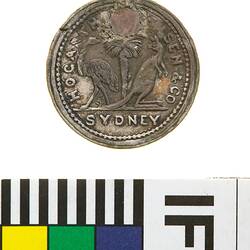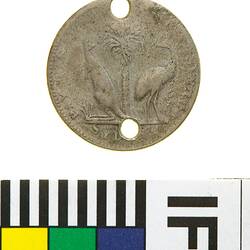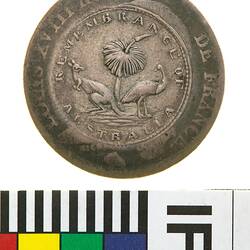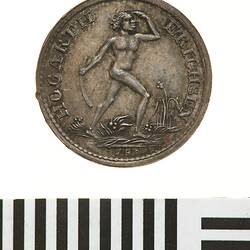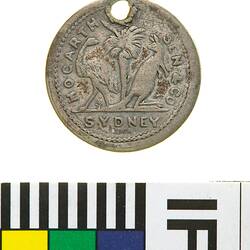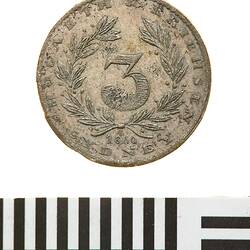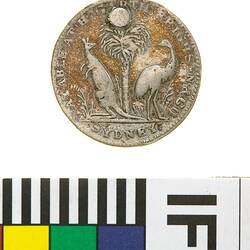Julius Hogarth and Conrad Erichsen were partners in a Sydney jewellery firm that struck silver threepence and fourpence tokens bearing their own name, most bearing the date 1858, and others without dates, c.1860. Apparently Hogarth had diesinking skills and Erichsen was the technician. Erichsen was also said to be in the habit of 'Striking a few whenever he felt in need of refreshment.' According to Andrews, the metal in some of their issues were of so low a quality that they were 'withdrawn under pressure from the government.' They are thought to have struck their tokens using J.C. Thornthwaite's press.
In his article 'Tokens of George Street,' numismatist Tom May provides the following chronology of their activities:
1852: Business opened at 394 George Street West 'a small shop.near Liverpool Street.outside the main business district.'
1856: Moved to 310 George Street West, 'between King and Market Streets.'
1857-1858: George Street renumbered, 310 West becoming 405.
1860: Moved to 312 George Street East 'in the same building as Skinner's Hotel, on the south east corner of Hunter Street. The former still exists today as the last convict era building in that part of Sydney.'
1863: Hogarth & Erichsen 'ceased trading', Hogarth opened a small business at 99 Hunter Street.
Research conducted by Museum Victoria during 2005 located information about the end of the business. On 7 May 1861, a notice was published in the Sydney Morning Herald, advising the public that Hogarth and Erichsen were insolvent, and that 'a first account current and plan of distribution showing payment of 20s.[shillings] in the pound on preferrent claims, and a first dividend of 7s. 6d. [pence] on concurrent claims,' was lodged with the relevant authorities and, if no objections were raised, would be confirmed on May 17. One week later another pair of notices were published, the first advising the public that the partnership had been dissolved. The second advised 'his friends and the public in general' that Julius Hogarth would be continuing in the jewellery trade, from 21 Hunter Street in Sydney. Erichsen did not give any notice of his intentions at that time.
Additional research has found the following addresses:
1864: Hogarth, 21 Hunter Street, p.r. (private residence) Pyrmont
1865: Hogarth, 6 Hunter Street (no further listings located)
1868: Erichsen, Conrad, Jeweller, 159 Crown Street
The corner of George and Hunter Streets, c.1849, is shown in an untitled painting held by the State Library of New South Wales, by Andrew Torning. 'Skinner's Family Hotel' is still standing, the last convict era building still standing in that part of Sydney. Both Skinner's hotel and Dixon's tobacconist (third shop from the corner) were still in business in 1860 when Hogarth & Erichsen moved into the second shop from the corner. The premises of their future neighbour and fellow token issuer, James MacGregor, are visible at the right of the picture.
After the partnership was dissolved, Hogarth did some work for Stokes in Melbourne, producing amongst other pieces 'The reverse of some very fair medals for the Exhibition in Melbourne in 1872,' (Andrews, p. 16). A Hogarth family descendant in Melbourne continues to do extensive research on the life and career of Julius Hogarth.
References:
Andrews, A. (1921). Australian Tokens and Coins. pp.16, 112-114.
May, Tom (1988). 'Tokens of George Street.' Australian Numismatist, Special Bicentenary Edition, pp.26-27
Torning, Andrew, Painting 'Corner of George and Hunter Streets.', circa 1849, State Library of New South Wales website http://wfxsearch.webfeat.org/wfsearch/search
'Notice to Creditor's'. Sydney Morning Herald, 7 May 1861, p.6.
'Notice of Dissolution of Partnership', Sydney Morning Herald, 14 May 1861, p.6.
More Information
-
Keywords
-
Localities
-
Authors
-
Article types


